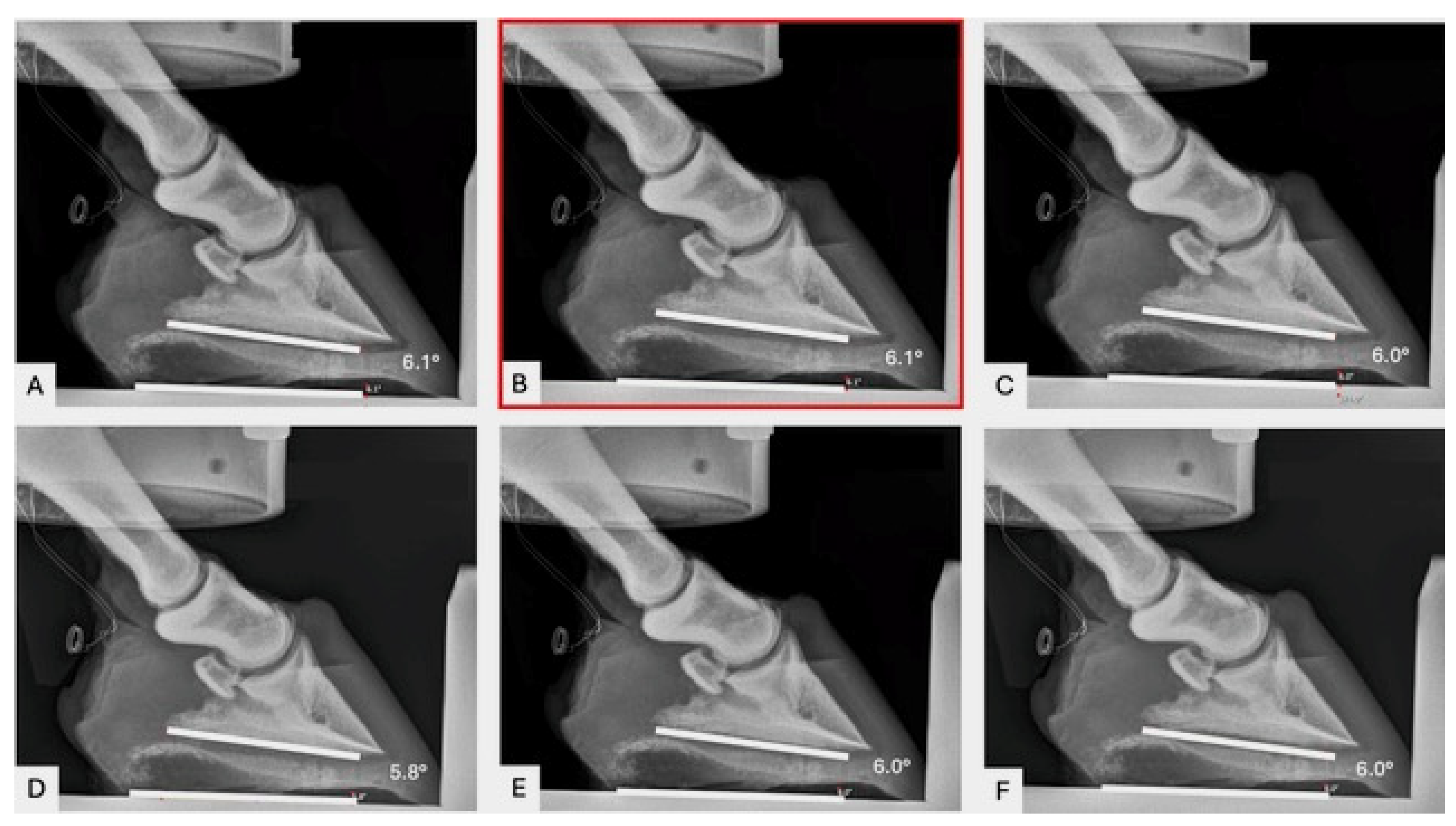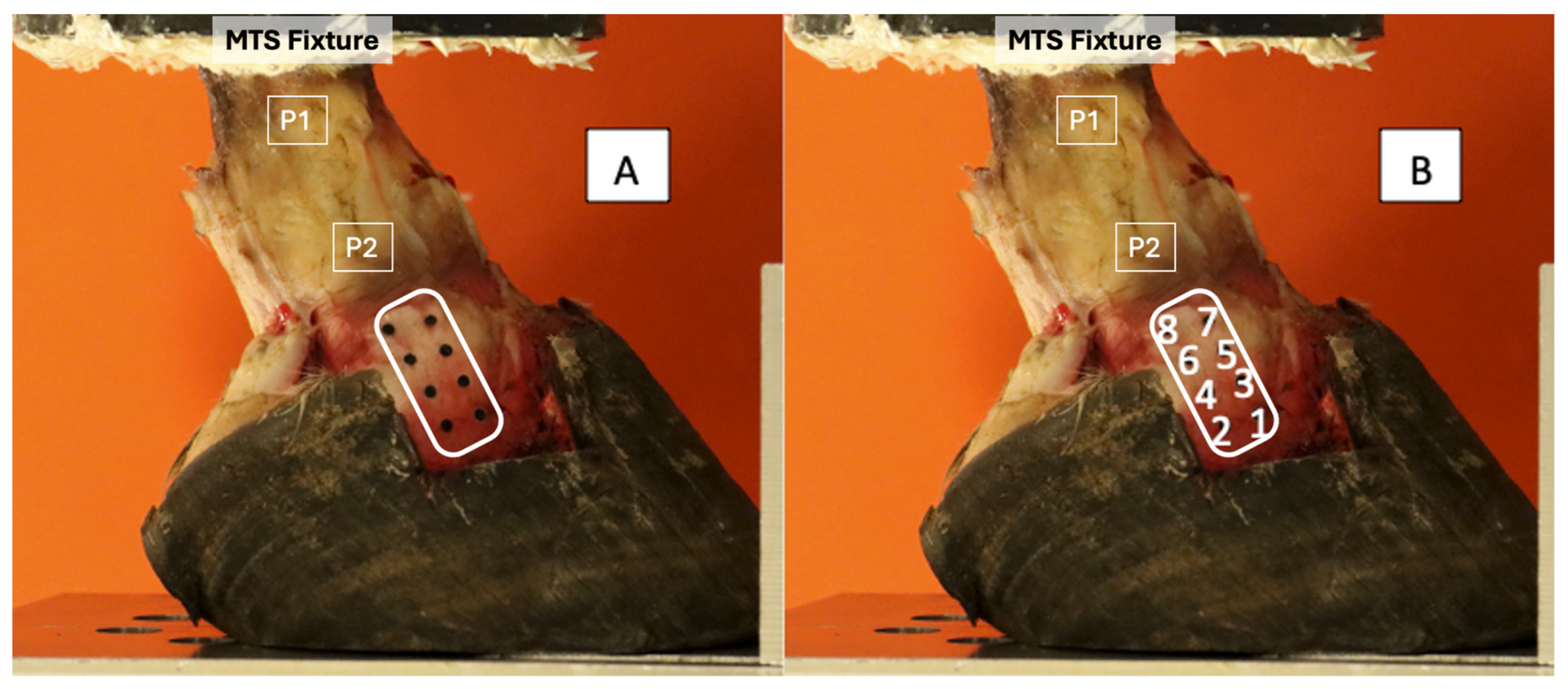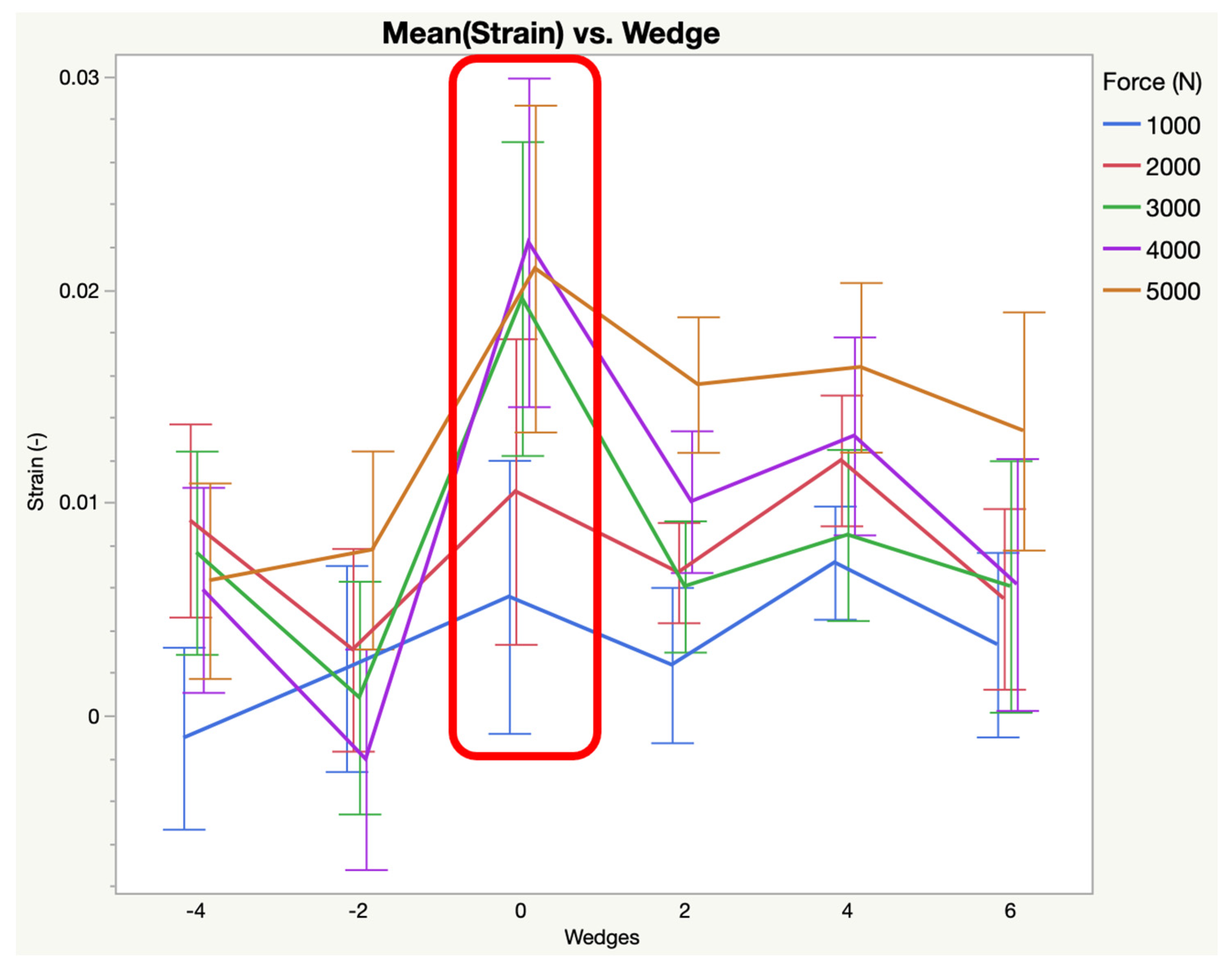Biomechanical Assessment of the Collateral Ligament of the Distal Interphalangeal Joint of the Horse Following Alterations to the Palmar Angle—A Cadaveric Study
Simple Summary
Abstract
1. Introduction
2. Materials and Methods
2.1. Limb Preparation
2.2. Radiography
2.3. Alterations to Palmar Angle
2.4. Biomechanical Assessment
2.5. Statistical Analysis
3. Results
4. Discussion
5. Conclusions
Author Contributions
Funding
Institutional Review Board Statement
Informed Consent Statement
Data Availability Statement
Acknowledgments
Conflicts of Interest
References
- Equine health Survey Highlights the Prevalence of Lameness. Vet. Rec. 2013, 173, 132. [CrossRef]
- Johnson, S.A.; Donnell, J.R.; Donnell, A.D.; Frisbie, D.D. Retrospective Analysis of Lameness Localisation in Western Performance Horses: A Ten-Year Review. Equine Vet. J. 2021, 53, 1150–1158. [Google Scholar] [CrossRef] [PubMed]
- O’Grady, S.E.; Ovnicek, G. Foot Care and Farriery. In Adams and Stashak’s Lameness in Horses; John Wiley & Sons, Inc.: Amsterdam, The Netherlands, 2020; pp. 1091–1142. [Google Scholar]
- Bras, R.; Morrison, S. Mechanical Principles of the Equine Foot. Vet. Clin. N. Am. Equine Pract. 2021, 37, 581–618. [Google Scholar] [CrossRef] [PubMed]
- Willemen, M.A.; Savelberg, H.H.; Barneveld, A. The Effect of Orthopaedic Shoeing on the Force Exerted by the Deep Digital Flexor Tendon on the Navicular Bone in Horses. Equine Vet. J. 1999, 31, 25–30. [Google Scholar] [CrossRef]
- Lawson, S.E.; Chateau, H.; Pourcelot, P.; Denoix, J.M.; Crevier-Denoix, N. Effect of Toe and Heel Elevation on Calculated Tendon Strains in the Horse and the Influence of the Proximal Interphalangeal Joint. J. Anat. 2007, 210, 583–591. [Google Scholar] [CrossRef]
- Meershoek, L.S.; Lanovaz, J.L.; Schamhardt, H.C.; Clayton, H.M. Calculated Forelimb Flexor Tendon Forces in Horses with Experimentally Induced Superficial Digital Flexor Tendinitis and the Effects of Application of Heel Wedges. Am. J. Vet. Res. 2002, 63, 432–437. [Google Scholar] [CrossRef] [PubMed]
- Riemersma, D.J.; van den Bogert, A.J.; Jansen, M.O.; Schamhardt, H.C. Influence of Shoeing on Ground Reaction Forces and Tendon Strains in the Forelimbs of Ponies. Equine Vet. J. 1996, 28, 126–132. [Google Scholar] [CrossRef] [PubMed]
- Crevier-Denoix, N.; Roosen, C.; Dardillat, C.; Pourcelot, P.; Jerbi, H.; Sanaa, M.; Denoix, J.M. Effects of Heel and Toe Elevation upon the Digital Joint Angles in the Standing Horse. Equine Vet. J. Suppl. 2001, 33, 74–78. [Google Scholar] [CrossRef]
- Chateau, H.; Degueurce, C.; Denoix, J.M. Three-Dimensional Kinematics of the Distal Forelimb in Horses Trotting on a Treadmill and Effects of Elevation of Heel and Toe. Equine Vet. J. 2006, 38, 164–169. [Google Scholar] [CrossRef]
- Viitanen, M.J.; Wilson, A.M.; McGuigan, H.R.; Rogers, K.D.; May, S.A. Effect of Foot Balance on the Intra-Articular Pressure in the Distal Interphalangeal Joint In Vitro. Equine Vet. J. 2003, 35, 184–189. [Google Scholar] [CrossRef] [PubMed]
- Denoix, J.-M.; Bertoni, L.; Heitzmann, A.-G.; Werpy, N.; Audigié, F. Ultrasonographic Examination of the Collateral Ligaments of the Distal Interphalangeal Joint in Horses: Part A: Technique and Normal Images. Equine Vet. Educ. 2011, 23, 574–580. [Google Scholar] [CrossRef]
- Denoix, J. Functional Anatomy of the Equine Interphalangeal Joints. In Proceedings of the American Association of Equine Practitioners, Albuquerque, NM, USA, 8 December 1999; pp. 174–177. [Google Scholar]
- Denoix, J.-M. The Equine Distal Limb: An Atlas of Clinical Anatomy and Comparative Imaging; CRC Press: Boca Raton, FL, USA, 2000. [Google Scholar]
- Beasley, B.; Selberg, K.; Giguère, S.; Allen, K. Magnetic Resonance Imaging Characterisation of Lesions Within the Collateral Ligaments of the Distal Interphalangeal Joint–28 cases. Equine Vet. Educ. 2020, 32, 11–17. [Google Scholar] [CrossRef]
- Dyson, S.J.; Murray, R.; Schramme, M.; Branch, M. Collateral Desmitis of the Distal Interphalangeal Joint in 18 Horses (2001–2002). Equine Vet. J. 2004, 36, 160–166. [Google Scholar] [CrossRef] [PubMed]
- Bushe, T.; Turner, T.; Poulos, P.; Harwell, N. The Effect of Hoof Angle on Coffin, Pastern and Fetlock Joint Angles. In Proceedings of the Annual Convention of the American Association of Equine Practitioners (USA), San Diego, CA, USA, 4–7 December 1988. [Google Scholar]
- Blaker, C.L.; Ashton, D.M.; Hartnell, N.; Little, C.B.; Clarke, E.C. Tendon Biomechanical Properties Are Altered by Storage Duration But Not Freeze-Thaw Temperatures or Cycles. J. Orthop. Res. 2024, 42, 1180–1189. [Google Scholar] [CrossRef]
- Seabaugh, K.A.; Hubert, J.D.; Kawcak, C.E.; McGilvray, K.C.; Santoni, B.G.; Rao, S.; Baxter, G.M. Effect of Sequential Removal of Parts of the Second Metacarpal Bone on the Biomechanical Stability of the Equine Carpus. Vet. Surg. 2012, 41, 862–868. [Google Scholar] [CrossRef]
- Staples, E.; Porter, E.; Mendoza, P.; Trolinger-Meadows, K.; Colee, J.; Morton, A. The Position of X-Ray Beam-Centring Affects Radiographic Measurements of Palmar Angle and Sole Thickness on Radiographs of the Equine Thoracic Distal Limb. Equine Vet. Educ. 2022, 34, e491–e496. [Google Scholar] [CrossRef]
- Clayton, H.M. Biomechanics of the Distal Interphalangeal Joint. J. Equine Vet. Sci. 2010, 30, 401–405. [Google Scholar] [CrossRef]
- Merritt, J.S.; Davies, H.M.; Burvill, C.; Pandy, M.G. Influence of muscle-tendon wrapping on calculations of Joint Reaction Forces In The Equine Distal Forelimb. J. Biomed. Biotechnol. 2008, 2008, 165730. [Google Scholar] [CrossRef]
- Brama, P.; Karssenberg, D.; Barneveld, A.; Van Weeren, P. Contact Areas and Pressure Distribution on the Proximal Articular Surface of the Proximal Phalanx Under Sagittal Plane Loading. Equine Vet. J. 2001, 33, 26–32. [Google Scholar] [CrossRef]
- Sisson, S. Chapter 16: Equine Syndesmology. In The Anatomy of the Domestic Animals, 5th ed.; Sisson, S., Grossman, J.D., Eds.; W B Saunders Co.: Philadelphia, PA, USA, 1975; 359p. [Google Scholar]
- Selberg, K.; Werpy, N. Fractures of the Distal Phalanx and Associated Soft Tissue and Osseous Abnormalities in 22 Horses with Ossified Sclerotic Ungual Cartilages Diagnosed with Magnetic Resonance Imaging. Vet. Radiol. Ultrasound 2011, 52, 394–401. [Google Scholar] [CrossRef] [PubMed]
- Dyson, S.J.; Murray, R.; Schramme, M.C. Lameness Associated with Foot Pain: Results of Magnetic Resonance Imaging in 199 Horses (January 2001–December 2003) and Response to Treatment. Equine Vet. J. 2005, 37, 113–121. [Google Scholar] [CrossRef] [PubMed]
- Dyson, S.; Murray, R. Magnetic resonance Imaging Evaluation of 264 Horses with Foot Pain: The Podotrochlear Apparatus, Deep Digital Flexor Tendon and Collateral Ligaments of the Distal Interphalangeal Joint. Equine Vet. J. 2007, 39, 340–343. [Google Scholar] [CrossRef] [PubMed]
- Gutierrez-Nibeyro, S.D.; White, N.A., 2nd; Werpy, N.M.; Tyrrell, L.; Allen, K.A.; Sullins, K.E.; Mitchell, R.D. Magnetic Resonance Imaging Findings of Desmopathy of the Collateral Ligaments of the Equine Distal Interphalangeal Joint. Vet. Radiol. Ultrasound 2009, 50, 21–31. [Google Scholar] [CrossRef] [PubMed]
- Parks, A. The Foot and Shoeing. In Diagnosis and Management of Lameness in the Horse; Elsevier: Amsterdam, The Netherlands, 2003; pp. 252–275. [Google Scholar]
- Dyson, S.J.; Tranquille, C.A.; Collins, S.N.; Parkin, T.D.H.; Murray, R.C. An Investigation of the Relationships Between Angles and Shapes of the Hoof Capsule and the Distal Phalanx. Equine Vet. J. 2011, 43, 295–301. [Google Scholar] [CrossRef]
- Dakin, S.; Dyson, S.; Murray, R.; Tranquille, C. Osseous Abnormalities Associated with Collateral Desmopathy of the Distal Interphalangeal Joint: Part 1. Equine Vet. J. 2009, 41, 786–793. [Google Scholar] [CrossRef]






| Changes to Palmar Angle | ||||||
|---|---|---|---|---|---|---|
| Region of the Ligament (Associated Marker Numbers) | 6° Wedge | 4° Wedge | 2° Wedge | Neutral | Reverse 2° Wedge | Reverse 4° Wedge |
| Distal width (1–2) | 0.0350 * (±0.0061) | 0.0271 * (±0.0061) | 0.0210 * (±0.0061) | 0.0036 (±0.0061) | 0.0168 * (±0.0062) | 0.0114 (±0.0061) |
| Distal dorsal length (1–3) | 0.0182 (±0.0044) | 0.0204 (±0.0043) | 0.0163 (±0.0044) | 0.0207 (±0.0044) | 0.0237 (±0.0044) | 0.0240 (±0.0044) |
| Distal palmar length (2–4) | 0.0069 * (±0.0033) | 0.0114 (±0.0033) | 0.0082 * (±0.0033) | 0.0159 (±0.0033) | 0.0027 * (±0.0033) | 0.0059 * (±0.0033) |
| Mid distal width (3–4) | 0.0404 * (±0.0072) | 0.0348 * (±0.0072) | 0.0300 (±0.0072) | 0.0274 (±0.0073) | 0.0307 (±0.0073) | 0.0341 (±0.0073) |
| Mid dorsal length (3–5) | 0.0022 (±0.0056) | 0.0052 (±0.0055) | 0.0062 (±0.0056) | 0.0087 (±0.0056) | 0.0020 (±0.0056) | −0.0042 * (±0.0056) |
| Mid palmar length (4–6) | −0.0379 (±0.0085) | −0.0366 (±0.0085) | −0.0399 (±0.0085) | −0.0389 (±0.0085) | −0.0424 (±0.0085) | −0.04015 (±0.0085) |
| Mid proximal width (5–6) | 0.0152 (±0.0061) | 0.0106 (±0.0060) | 0.0072 (±0.0061) | 0.0138 (±0.0061) | 0.0105 (±0.0061) | 0.0148 (±0.0061) |
| Proximal dorsal length (5–7) | −0.0282 (±0.0037) | −0.0259 (±0.0037) | −0.0265 (±0.0037) | −0.0288 (±0.0038) | −0.0377 * (±0.0038) | −0.0404 * (±0.0038) |
| Proximal palmar length (6–8) | −0.0527 (±0.0071) | −0.0549 (±0.0071) | −0.0609 (±0.0071) | −0.0564 (±0.0071) | −0.0688 * (±0.0071) | −0.0738 * (±0.0071) |
| Proximal width (7–8) | 0.0114 (±0.0058) | 0.0110 (±0.0058) | 0.0099 (±0.0058) | 0.0127 (±0.0058) | 0.0019 * (±0.0058) | 0.0020 * (±0.0058) |
Disclaimer/Publisher’s Note: The statements, opinions and data contained in all publications are solely those of the individual author(s) and contributor(s) and not of MDPI and/or the editor(s). MDPI and/or the editor(s) disclaim responsibility for any injury to people or property resulting from any ideas, methods, instructions or products referred to in the content. |
© 2025 by the authors. Licensee MDPI, Basel, Switzerland. This article is an open access article distributed under the terms and conditions of the Creative Commons Attribution (CC BY) license (https://creativecommons.org/licenses/by/4.0/).
Share and Cite
Colla, S.; Johnson, J.W.; McGilvray, K.C.; Zanotto, G.M.; Seabaugh, K.A. Biomechanical Assessment of the Collateral Ligament of the Distal Interphalangeal Joint of the Horse Following Alterations to the Palmar Angle—A Cadaveric Study. Animals 2025, 15, 406. https://doi.org/10.3390/ani15030406
Colla S, Johnson JW, McGilvray KC, Zanotto GM, Seabaugh KA. Biomechanical Assessment of the Collateral Ligament of the Distal Interphalangeal Joint of the Horse Following Alterations to the Palmar Angle—A Cadaveric Study. Animals. 2025; 15(3):406. https://doi.org/10.3390/ani15030406
Chicago/Turabian StyleColla, Sandro, James W. Johnson, Kirk C. McGilvray, Gustavo M. Zanotto, and Kathryn A. Seabaugh. 2025. "Biomechanical Assessment of the Collateral Ligament of the Distal Interphalangeal Joint of the Horse Following Alterations to the Palmar Angle—A Cadaveric Study" Animals 15, no. 3: 406. https://doi.org/10.3390/ani15030406
APA StyleColla, S., Johnson, J. W., McGilvray, K. C., Zanotto, G. M., & Seabaugh, K. A. (2025). Biomechanical Assessment of the Collateral Ligament of the Distal Interphalangeal Joint of the Horse Following Alterations to the Palmar Angle—A Cadaveric Study. Animals, 15(3), 406. https://doi.org/10.3390/ani15030406





